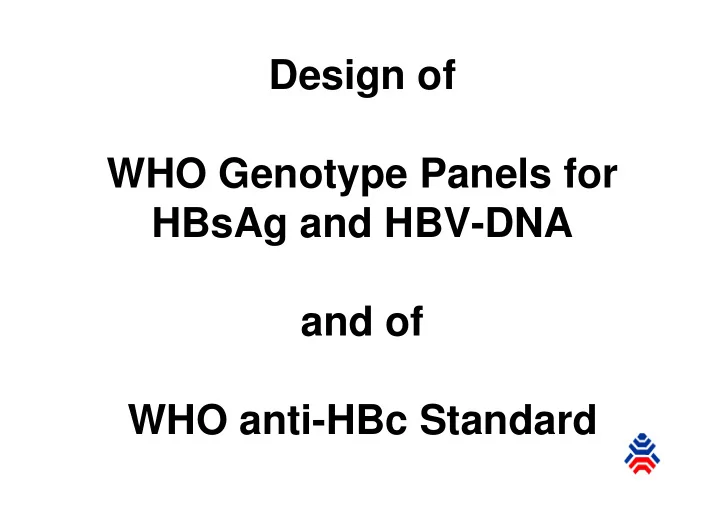

Design of WHO Genotype Panels for HBsAg and HBV-DNA and of WHO anti-HBc Standard
WHO Genotype Panels for HBsAg and HBV-DNA
Worldwide distribution of HBV genotypes
Worldwide Frequency Distribution Worldwide Frequency Distribution of Chronic HBV Infections of Chronic HBV Infections HBsAg Prevalence ≥ 8% - High 2-7% - Medium <2% - Low
WHO International Standards • WHO IS HBsAg genotype A, subtype A2 • WHO IS HBV-DNA genotype A representing only 1% of HBV-infected population
HBV genotype panels WHO Consultation on “Global Measurement Standards and their use in the in vitro Biological Diagnostic Field" (Geneva, June 7-8, 2004) “….it was agreed that the contribution of other Hepatitis B virus genotypes on the sensitivity of test kits for HBsAg should be investigated further. It is recommended that Regulatory Authorities devise panels for kit evaluation that include HBsAg reactive specimen with subtypes and genotypes from their local regions."
HBV genotype Panels Aim • HBsAg panel • HBV-DNA panel from the same hi(+) units reflecting all major HBV-genotypes / major genosubtypes if lyophilisation: validation no inactivation step project introduced to and accepted by ECBS 2005 Cooperation: Prof W. Gerlich (Univ. Giessen)
HBV genotype panels -current status- • collection of plasma units worldwide – plasma from Russia, Germany, Japan, Brasil, South Africa arrived at PEI – represent genotypes A, B, C, D, (E), (F) and mixed genotypes – plasma from Brasil (genotype F?), Egypt, China and Iran has been announced
HBV-genosubtypes: worldwide distribution Genotype Genosubtype HBsAg subtype Frequency Main Geographical Distribution A A1 adw2, ayw1 high Africa A2 adw2 high Europe, North America, Australia A3 Cameroon, Democratic Republic of Congo, Gabon B B1 adw2 high Far East (Japan, China, Taiwan) B2 adw2/adw3, high/low Far East (China, Japan, Vietnam/Thailand) B3 adw2 high Far East (Indonesia, Sumatra, Sulawesi) B4 ayw1 high Vietnam C C1 adr/ayr/adw2 high/high/low Far East (Japan, China) C2 adr/ayr; ad high/high Thailand, China/Vietnam C3 adrq-/adw2 high/low Pacific (New Zealand to Polynesia), Micronesia/Far East C4 low Northeast Australia ayw3 D D1 ayw2 high Mediterranean, Middle East, India D2 ayw3/ayw4 high/low worldwide/USA D3 ayw2/ayw3 high/high South Africa, Alaska/Europe, Costa Rica D4 ayw2, high Oceania, Somalia, not identified adw3 low Eastern Europe Spain E - ayw4 high Africa F F1 adw4q-/ayw4 high/low Cental America, Argentina, Spain, Alaska/Nicaragua F2 adw4q-/ayw4 high/low South America, Polynesia, France/Venezuela G - adw2 low USA, Mexico, Europe H - adw4 low Central America (Nicaragua, Mexico), California Recombinant Strains A/D India adw2 C/D ayw2 Tibet C/? adw2 Vietnam
HBV genotype panels Current work • Characterization of candidate materials (HBsAg, HBV-DNA, Sequencing) • Pilot experiments to separate HBsAg from infectivity (HBV-DNA) and to fully characterize candidate materials (Prof W Gerlich, Univ. Giessen)
HBV genotype panels Prof Gerlich (Giessen) • Pelleting of infectivity (99,9%) by sucrose ultracentrifugation dilution in plasma for HBV-DNA genotype panel • Enrichment of 20 nm filaments by sucrose gradient centrifugation and flotation in CsCl • HBsAg content by Laurell immune-electrophoresis • residual HBV-DNA by qtNATs dilution in plasma for HBsAg genotype panel
WHO IS antiHBc
WHO IS antiHBc antiHBc • serological marker for past HBV-infection • in rare cases HBV-DNA (low+) • in rare cases HBV-transmissions reported from antiHBc- pos donors to recipients • blood screening marker in several countries – previously as surrogate marker for NANBH – considerations to rely in future on antiHBc combined with ID HBV-NAT
WHO IS antiHBc What is the ideal candidate material ? • „heterogenous“ antiHBc-assays – competitive / non-competitive assays – reducing agents in specimen diluent for increase of specificity? – often same antigen source – „confirmation“ of unspecific results by „different“ assays • no confirmation assay for antiHBc • no common algorithm for „antiHBc-positive“
WHO IS antiHBc What is the ideal candidate material ? • no strict correlation between analytical (=dilutional) and diagnostic sensitivity of antiHBc-assays • WHO antiHBc standard could be useful for – defining minimal diagnostic sensitivity of assays – quality control of batches
�������� ��������������������������� ������������������������������������� ����� ������������������������������������������������������������������������������������������� ������� !""#$� ��� ��������� ��� !%&'!(% • screening of 10.000 blood donors with 2 antiHBc-assays • characterization of all antiHBc-reactive donations (207) using – 7 further antiHBc-assays – antiHBs-assays, antiHBe-assay – 3 HBV-NATs
�������� ��������������������������� ������������������������������������� ����� ������������������������������������������������������������������������������������������� ������� !""#$� ��� ��������� ��� !%&'!(% antiHBc-reactivity in 9 different assays Characterization of 207 antiHBc-reactives ≥ 5/9 assays 9/9 assays <5/9 assays antiHBc only 27 (13%) 10 17 HBV-DNA pos: 1 one second antiHBc 67 (32%) 49 11 7 marker pos + antiHBs >100 mIU antiHBs/ml: 49 <100 mIU antiHBs/ml: 18 antiHBc 7 (3%) 7 + antiHBe both second antiHBc 106 (51%) 106 markers pos + antiHBs >100 mIU antiHBs/ml: 98 <100 mIU antiHBs/ml: 8 + antiHBe 207 162 (78%) 21 (10%) 24 (12%) 173 (84%) antiHBs-pos
�������� ��������������������������� ������������������������������������� ����� ������������������������������������������������������������������������������������������� ������� !""#$� ��� ��������� ��� !%&'!(% antiHBc-reactivity in 9 different assays Characterization of 207 antiHBc-reactives ≥ 5/9 assays 9/9 assays <5/9 assays s/co-values antiHBc high low antiHBc only 27 (13%) 10 17 HBV-DNA pos: 1 one second antiHBc 67 (32%) 49 11 7 marker pos + antiHBs >100 mIU antiHBs/ml: 49 <100 mIU antiHBs/ml: 18 antiHBc 7 (3%) 7 + antiHBe both second antiHBc 106 (51%) 106 markers pos + antiHBs >100 mIU antiHBs/ml: 98 <100 mIU antiHBs/ml: 8 + antiHBe 207 162 (78%) 21 (10%) 24 (12%) 173 (84%) antiHBs-pos
Serological Pattern of antiHBc-/HBV-DNA positives (in-house NAT, Frankfurt) Characterization of antiHBc-reactivity in 11 different assays 10 antiHBc-/HBV-DNA positives ≥ 6 assays ≤ 5 assays 11 / 11 assays s/co-values antiHBc high low antiHBc only 4 3 1 one second antiHBc 2 2 marker pos + antiHBs antiHBc 1 1 + antiHBe both second antiHBc 3 3 markers pos + antiHBs + antiHBe 10
Recommend
More recommend